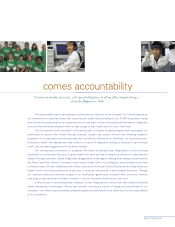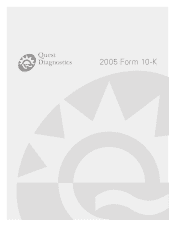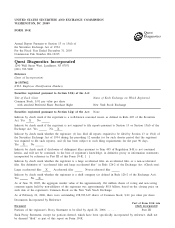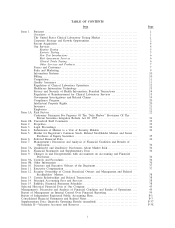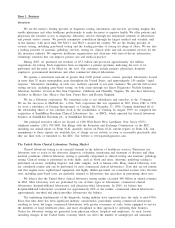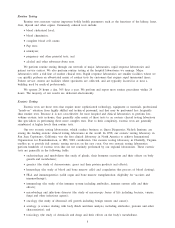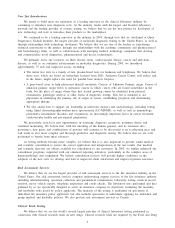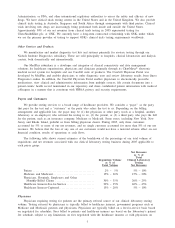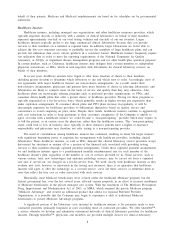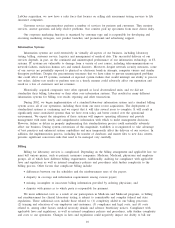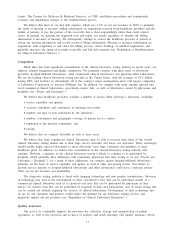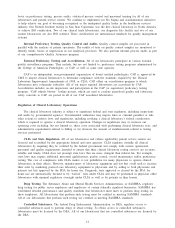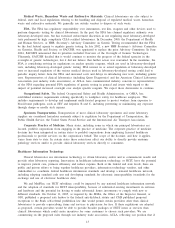Quest Diagnostics 2005 Annual Report Download - page 23
Download and view the complete annual report
Please find page 23 of the 2005 Quest Diagnostics annual report below. You can navigate through the pages in the report by either clicking on the pages listed below, or by using the keyword search tool below to find specific information within the annual report.New Test Introductions
We intend to build upon our reputation as a leading innovator in the clinical laboratory industry by
continuing to introduce new diagnostic tests. As the industry leader with the largest and broadest laboratory
network and the leading provider of esoteric testing, we believe that we are the best partner for developers of
new technology and tests to introduce their products to the marketplace.
We continued to be a leading innovator in the industry in 2005, through tests that we developed at Quest
Diagnostics Nichols Institute, the largest provider of molecular diagnostic testing in the United States, as well as
through relationships with technology developers. We believe that we are one of the leaders in transferring
technical innovations to the market, through our relationships with the academic community and pharmaceutical
and biotechnology firms, as well as collaborations with emerging medical technology companies that develop
and commercialize novel diagnostics, pharmaceutical and device technologies.
We primarily focus our resources on three disease states, cardiovascular disease, cancer and infectious
disease, as well as on continued advancements in molecular diagnostics. During 2005, we introduced
approximately 75 new and improved assays, including:
•The initial two tests in a family of new plasma-based tests for leukemia and lymphoma. We believe that
these tests, which are based on technology licensed from M.D. Anderson Cancer Center, will reduce and,
in the future, might replace the need for painful bone marrow biopsies.
•A gene-based assay to help physicians identify metastatic Cancers of Unknown Primary origin. Cancer of
unknown primary origin refers to metastatic cancer in which cancer cells are found somewhere in the
body, but the place of origin where they first started growing cannot be identified from physical
examination, pathologic analysis or other forms of diagnostic testing. This test is intended to aid
physicians in identifying the primary site of origin of cancer, establishing prognosis and determining
appropriate therapy.
•We also added tests to support our leadership in infectious diseases and endocrinology, including testing
using liquid chromatography-tandem mass spectrometry (LC-MS/MS), as well as tests in immunology,
particularly autoimmune disorders and coagulation, an increasingly important factor in cancer treatment,
cardiovascular health and pre-surgical preparation.
We proactively search for new opportunities in screening, diagnosis, prognosis, treatment choice and
treatment monitoring. We believe that, with the unveiling of the human genome, and its extension into
proteomics, new genes and combinations of proteins will continue to be discovered at an accelerating pace and
will result in ever more complex and thorough predictive and diagnostic testing. We believe that we are well
positioned to benefit from these advances.
As testing methods become more complex, we believe that it is also important to provide sound medical
and scientific consultation to ensure the correct application and interpretation of the test results. Our medical
and scientific directors are always available for consultation to our customers. In 2005, we further enhanced our
consultation programs, supported with our enhanced reporting initiatives, particularly in the complex areas of
hematopathology and coagulation. We believe consultation services will provide higher confidence in the
adoption of the new tests we develop and lead to improved client satisfaction and improved patient outcomes.
Risk Assessment Services
We believe that we are the largest provider of risk assessment services to the life insurance industry in the
United States. Our risk assessment services comprise underwriting support services to the life insurance industry
including teleunderwriting, specimen collection and paramedical examinations, laboratory testing, medical record
retrieval, motor vehicle reports, telephone inspections and credit checks. The laboratory tests performed and data
gathered by us are specifically designed to assist an insurance company in objectively evaluating the mortality
and morbidity risks posed by policy applicants. The majority of the testing is performed on specimens of
individual life insurance policy applicants, but also includes specimens of individuals applying for individual and
group medical and disability policies. We also provide risk assessment services in Canada.
Clinical Trials Testing
We believe that we are the world’s second largest provider of clinical laboratory testing performed in
connection with clinical research trials on new drugs. Clinical research trials are required by the Food and Drug
6


